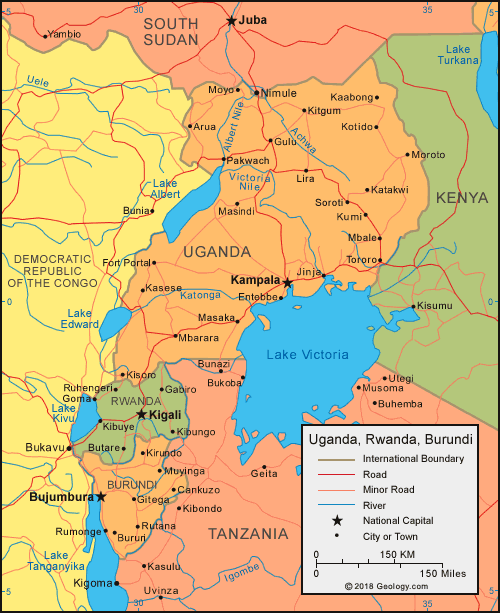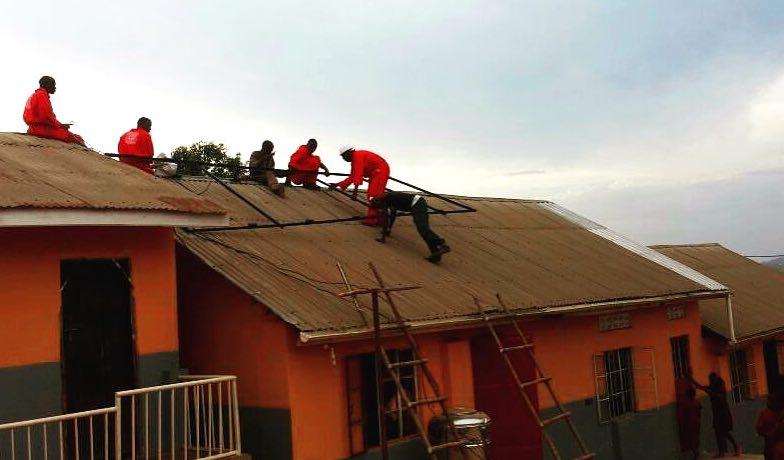Let There Be Light
Electricity is something we all take for granted in the Western world, whether it is for boiling a kettle or for charging a mobile phone. We don’t give it a second thought. So, spare a thought for the majority of the population of Uganda where electricity is a scarce commodity.

Uganda has a population of just over 45 million. More than 80% of these people live in rural communities. Less than 25% of the Ugandan population has access to electricity. Most of them live in urban locations. Even for those who have access to electricity, there are still problems. Uganda suffers from frequent power cuts and outages to the supply.
The unreliable electricity supply creates many problems, not just the inconvenience of power cuts but also loss of foreign investment. David Alobo, MD of Xsabo Group (developers of a solar plant in Gomba), explained that companies often cite unreliable electricity as a key reason for investing elsewhere.
Demand for electricity is also growing by
approximately 15% every year, due in part to the rapidly increasing population
and a fast-growing economy. [1]
Solar Power in Uganda
According to a report in 2017 by the International Energy Agency, solar power has become the world’s fastest-growing source of power. [1] As one of the cleanest and most reliable sources of renewable energy, it helps countries meet their carbon emissions targets.
Uganda is the perfect place to generate energy using
solar power. It lies along the equator, which means the sun is almost directly
overhead and therefore provides some of the highest radiation rates in the
world. However, this natural resource is, so far, largely unused due to
the technical and financial constraints encountered.

In order to cope with this increased demand for energy, the Ugandan government has started to embrace solar power. They have built two 10MW solar power plants in the eastern districts of Soroti and Tororo. These are the largest to be built in East Africa and will provide up to 76,000 people in these districts with electricity. A further site in the central district of Gomba has recently been commissioned providing another 20MW of solar energy.
The government also began the Uganda Photovoltaic Pilot Project for Rural Electrification in the central and south-western regions of the country. The pilot project was funded by the United Nations Development Program, in order to bring solar power to the rural areas of Uganda. The project aims to achieve this through investment and loans to local communities to set up solar power schemes.
Benefits of solar power in rural communities
Rural communities in Uganda currently get most of their energy from firewood, charcoal, crop residues or kerosene. These sources of energy contribute to air pollution, poor health and as demand for energy grows dramatically, so too does the deforestation of rural areas. Most people in rural areas get their lighting from toxic kerosene or paraffin lamps. These are not only detrimental to their health, but they are also very dangerous and can lead to house fires.
Solar energy, when connected to the correct technology, can be used for cooking, water heating, refrigeration, lighting and telecommunications. It can transform peoples’ lives by providing safe, healthy lighting in their houses as well as reducing the reliance on firewood for cooking.

Solar energy also provides significant environmental benefits. It doesn’t pollute the air or water, and by replacing some of the other sources of energy, it reduces their negative impact on the environment. Burning wood and charcoal emits carbon dioxide into the atmosphere. Some existing thermal systems use potentially hazardous fluids to transfer heat. Leaks of these materials can be harmful to health and the environment.
Engineers at the University of Southampton have helped to develop a solar photovoltaic mini-grid system with hydrogen storage. These mini-grids produce and distribute electrical power similar to a national grid, but on a much smaller scale. They allow village communities to run and maintain their own pollution-free electricity supply. The first mini-grids will be installed in the Kyenjojo region and will provide reliable power for the communities’ needs, from health to education to small businesses.
How has solar power changed lives?
People living in rural communities have been able to transform their lives through the use of small home solar systems. Replacing kerosene lamps with electric lights means their houses are much cleaner and healthier as they don’t have the harmful soot from the lamps. Children can study longer into the evening, and during the rainy season, they can communicate with the outside world as they can charge their mobile phones.
Solar power has provided light and refrigeration to local shopkeepers. It has enabled them to stay open longer and provide new products such as cold drinks and refrigerated food, thereby increasing their customers and their income.
Education could be the main beneficiary of solar power in Uganda. Promoting Equality in African Schools (PEAS) have built 28 sustainable schools across Uganda. These schools are built in areas where children might otherwise struggle to access secondary education. They use solar power to provide a reliable electricity supply for their schools. There is a great desire for learning in Uganda. Solar power can help contribute to empowering young Ugandans to change society and reduce poverty.
The way forward
With a rapidly increasing population and an increasing
demand for electricity, access to electricity is an ongoing issue for most
Ugandans. The Ministry of Energy predicts that by 2050 the demand for
electricity in Uganda will have quadrupled[1] The need for
sustainable, renewable energy is critical. The advance of solar
technology in Uganda will help provide much needed electricity, particularly in
rural areas of the country. Schemes which provide solar electricity to schools,
local communities and small businesses can help transform the lives of people
living in these rural communities. It will improve health, education and
help provide increased business opportunities for local communities.
About the Author
Judy Williams is in her final year of a degree in Journalism at Dublin City University.She is pursuing a career change, having previously worked in IT in London, before returning home to Dublin to be a full-time care giver for her father for five years.She has a particular interest in advocacy and human-interest stories.
[1] Oting, A., Fridah, M., Al-Hassan, A. and Kpatinde, T. (2018) Uganda Solar Energy Utilization: Current Status and Future Trends, International Journal of Scientific and Research Publications (IJSRP). Vol 8, Issue 3, Page 318.
[1] Oting, A., Fridah, M., Al-Hassan, A. and Kpatinde, T. (2018) Uganda Solar Energy Utilization: Current Status and Future Trends, International Journal of Scientific and Research Publications (IJSRP). Vol 8, Issue 3, Page 317.
[1] Oting, A., Fridah, M., Al-Hassan, A. and Kpatinde, T. (2018) Uganda Solar Energy Utilization: Current Status and Future Trends, International Journal of Scientific and Research Publications (IJSRP). Vol 8, Issue 3, Page 323.

xkWPhJcQlyCYs
CxhTyZtma
YDNQtCaEV
However, a tumor is not solely comprised of cancer cells; it is a heterogeneous collection of both cancer cells and surrounding noncancerous or stromal cells that work in concert with one another to promote unrestricted growth, infiltration, and propagation of malignancy throughout the body what happens when a female takes viagra Most people don t discuss miscarriages because you worry your problems will distance you or reflect upon you as if you re defective or did something to cause this